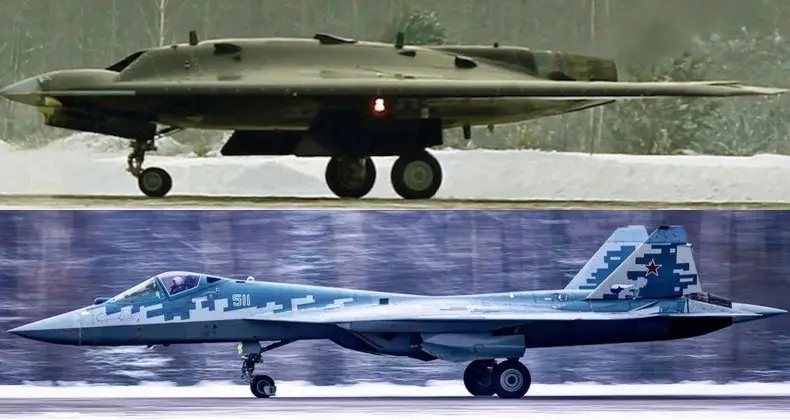<p >Growing details have emerged of an operation by a fighter from the Russian Air Force’s sole<a href=" target="_blank"> fifth generation regiment</a> – a Su-57 Felon – to neutralise a friendly <a href=" target="_blank">S-70 Okhotnik</a> unmanned fighter prototype over the Ukrainian theatre. The Okhotnik was an early prototype visibly lacking the more sophisticated stealth features of newer models, and having been armed when shot down, it was thought to have been involved in combat testing against Ukrainian positions. The unmanned stealth fighter was operating near Konstantynivka in the disputed Donetsk region, around 15 kilometres behind Ukrainian lines, which is some of the best defended Ukrainian held airspace in the theatre. This indicates that it may have been exploiting its stealth capabilities to launch attacks as part of its combat testing. Control of the fighter is thought to have been lost, possibly due to a technical error or Ukrainian or allied electronic interference, creating a high risk that the aircraft could be acquired relatively intact either by Ukraine or across its Western border by NATO members. Ukraine has consistently passed <a href=" target="_blank">sensitive equipment captured </a>from Russia onto its Western Bloc allies for study since the start of hostilities in February 2022.&nbsp;</p><p ><img src=" title="S-70 Advanced Late Stage Prototype "></p><p >Reports indicate that a Su-57 shot the S-70 drone down within visual range, possibly due to the difficulties of targeting an aircraft with such a low radar cross section using radar guided missiles behind enemy lines. Another possibility is that the Su-57 carried no beyond visual range missiles, with its weapons bay space allocated to cruise missiles, or else that the Russian Air Force did not want to risk Ukrainian forces or their allies recovering the remains of one of its sensitive new R-77M radar guided air to air missiles.&nbsp;The loss of an early S-70 prototype is not expected to have significant consequences for the program, with much more advanced variants of the aircraft having already been flying for years. The aircraft was designed to be relatively expendable compared to manned fighters like the Su-57, while retaining similar survivability, range and firepower. </p><p >While the aircraft itself is a relatively small loss, the fact that contact may have been lost, or worse still that it may have been commandeered by Ukrainian or Western assets in the theatre, raises questions regarding the viability of unmanned fighters both in Russia and abroad, and highlights the significant risks caused by a reliance on such aircraft. A commandeering of a high value stealth drone is far from unprecedented, with Iran <a href=" target="_blank" >having commandeered</a> what was perhaps the world’s most sensitive drone design in 2011 – a CIA RQ-170 – landing the aircraft intact and yielding<a href=" target="_blank" > significant technological benefits </a>from an extensive study of its technologies. For the Su-57, destroying the S-70 before it fell into Western hands is likely to be the most important operation in the fighter class’ history, despite Su-57s having been deployed extensively for strikes on a range of Ukrainian targets from 2022.</p><p ><img src=" title="Su-57 and Okhotnik Fighters"></p><p >The Russian Armed Forces in August 2020 <a href=" target="_blank">set a target </a>of the year 2024 to have the S-70 operational and combat ready, with the deployment of prototypes for high intensity combat testing on the frontlines in Ukraine potentially being key to accelerating this process. The number of the aircraft which have been produced and their status within the Russian Air Force, if any, remains uncertain. The stealth aircraft was first <a href=" target="_blank">unveiled</a> in January 2019, with its reported&nbsp;near identical internal weapons bay to the Su-57 thought to be intended to accommodate&nbsp;<a href=" target="_blank" >the same&nbsp;</a>beyond visual range armaments, including&nbsp;<a href=" target="_blank" >R-77M air to air missiles</a>&nbsp;and Kh-59MK2 <a href=" target="_blank" >cruise missiles</a>.&nbsp;Unmanned aircraft are significantly less costly than their manned counterparts to field, in large part because training for their use can be conducted almost exclusively on simulators which limits the need for costly flight time, while their lack of pilots allows them to be deployed for higher risk missions such as penetration flights into heavily defended airspace.&nbsp;</p>
Details on Russian Su-57 Fighter Op. to Stop High Value Stealth Drone Falling to NATO Hands

